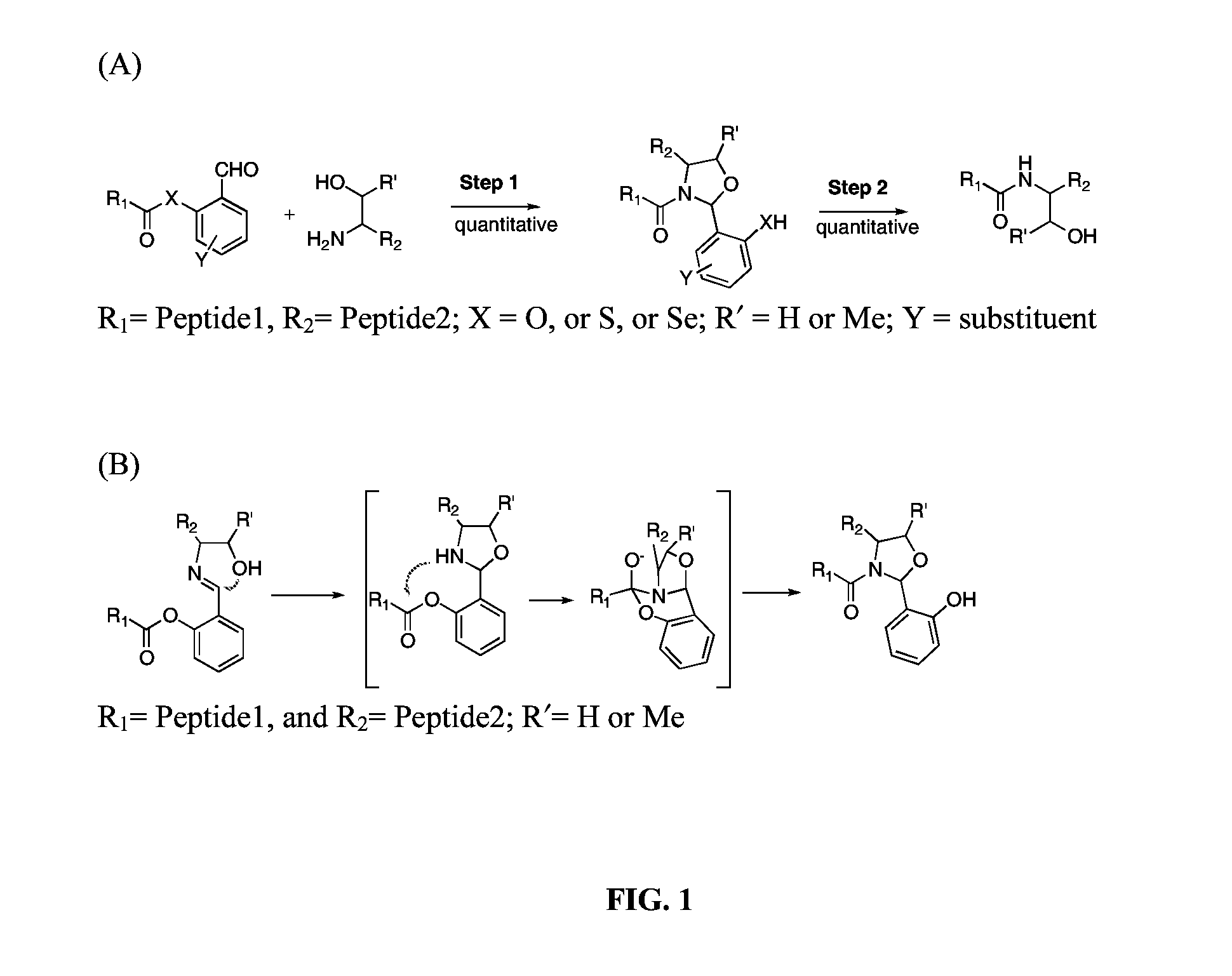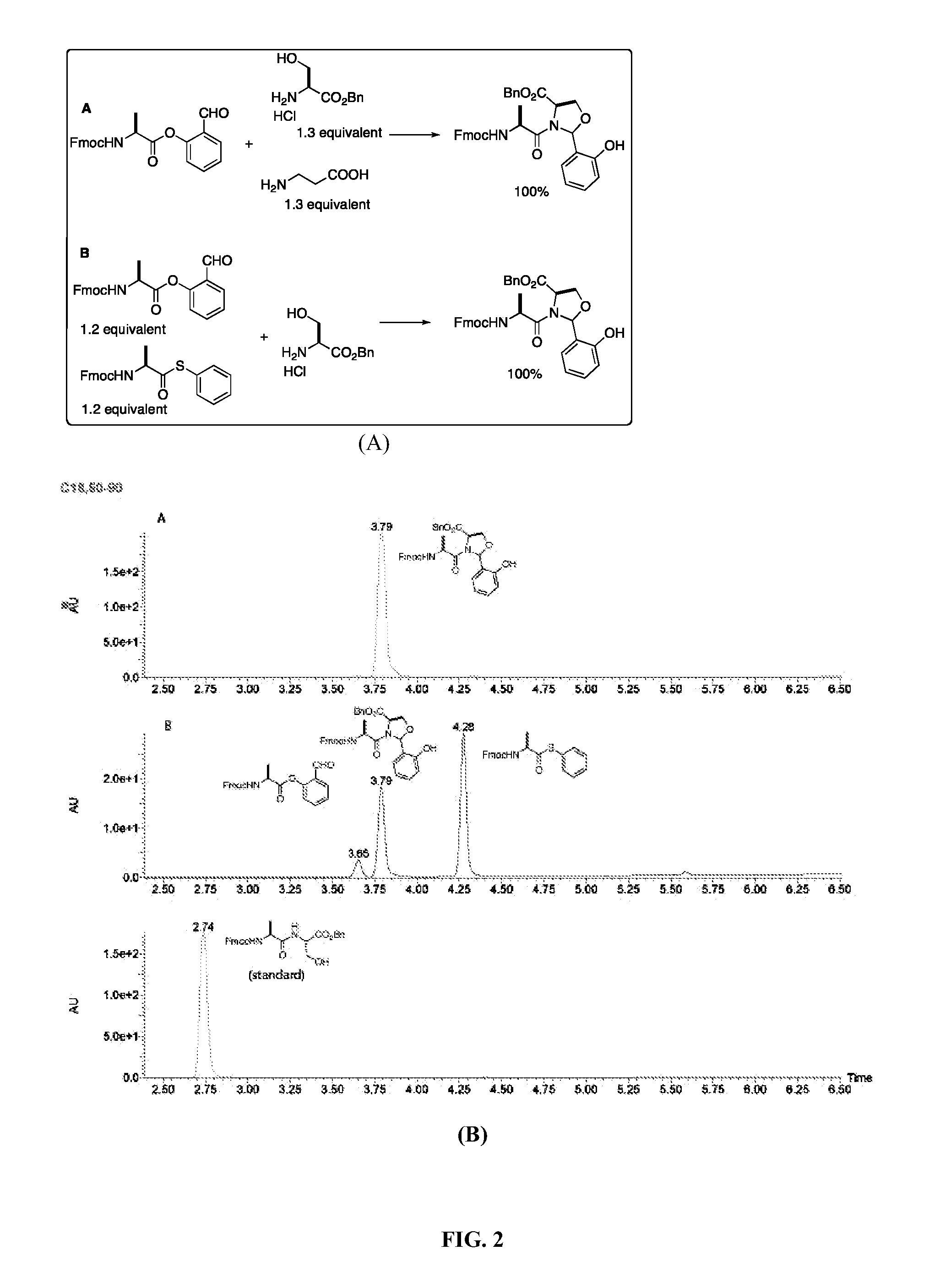Native chemical ligation at serine and threonine sites
a chemical ligation and serine site technology, applied in the direction of peptides, peptide/protein ingredients, peptide sources, etc., can solve the problems of difficult to achieve a chemoselective, the method of achieving a convergent synthesis of polypeptides becomes critical, and the availability of a chemoselective becomes critical, so as to facilitate the chemical synthesis of proteins and reduce the production cost. , the effect of facilitating
- Summary
- Abstract
- Description
- Claims
- Application Information
AI Technical Summary
Benefits of technology
Problems solved by technology
Method used
Image
Examples
example 1
[0030]As a model study, FmocAla with salicylaldehyde ester at the C-terminal was prepared by coupling FmocAla-OH with salicylaldehyde using dicyclohexylcarbodiimide under standard ester formation conditions. A typical procedure for Ser / Thr NCL is as follows: FmocAla-salicylaldehyde ester (3.8 mg, 9.15 μmol) and serine benzyl ester (2.5 mg, 10.8 μmol) are mixed in a solution (183 μl, pyridine / acetic acid, 1:1, mol / 1 mol) at a concentration of 0.05 M. The reaction mixture is stirred at room temperature and is monitored by LCMS. After 30 min, a single new product in 80% conversion is observed, corresponding to the N,O-benzylidene acetal adduct. The reaction goes to completion within 2 hours to afford the coupled product with the N, O-benzylidene acetal in between. The N,O-benzylidene acetal adduct can be isolated. NMR spectrum of the N,O-benzylidene adduct appears as two compounds, which is derived from the new generated chiral center. (Fmoc=fluorenylmethyloxycarbonyl, LCMS=liquid chro...
example 2
[0032]The significant feature of the present method is its chemoselectivity. To demonstrate the chemoselectivity, using the same condition as described above, the Ala-salicylaldehyde ester reacts with a serine derivative in the presence of an unprotected β-alanine. Moreover, the Ala-salicylaldehyde ester reacts with a serine derivative in the presence of an Ala-thiophenol ester. The reaction is monitored by LCMS and the reaction product is determined by ESI (electrospray mass spectrometry). In both cases, a single product of the expected mass as the N,O-benzylidene adduct is observed (FIG. 2). The thiophenol ester is a very reactive acyl donor. It is reported to directly condense with an amine to give an amide bond and readily hydrolyze. Under the condition of the present invention, the thiophenol ester is stable within the reaction time and does not acylate the amino group directly. These results also demonstrate that the nucleophilic amine does not interfere the ligation process.
example 3
[0033]The β-branched amino acids, such as valine, proline, threonine, and isoleucine have been considered as difficult site when used at the C-terminus for chemical ligations. The scope of the serine-based ligation of the present invention is explored with Fmoc-Val-salicylaldehyde ester, Fmoc-Pro-salicylaldehyde ester Fmoc-Ile-salicylaldehyde ester Fmoc-Val-Thr-salicylaldehyde ester coupling with a serine benzyl ester derivative. All ligations are performed at a concentration of 0.05 M, as described in EXAMPLE 1. The reaction is stirred at room temperature and monitored by LCMS. All ligations proceed rapidly and efficiently, resulting in full conversion in less than 5 hours in quantitative conversion for valine, proline and threonine. The exception is that the ligation between isoleucine and serine is rather slow (FIG. 5). After removal of the solvent from the above reactions, the residue is then subjected to TFA / H2O / iPr3SiH condition. In 5 min, the ligated products in the native pe...
PUM
| Property | Measurement | Unit |
|---|---|---|
| time | aaaaa | aaaaa |
| flow rate | aaaaa | aaaaa |
| stable | aaaaa | aaaaa |
Abstract
Description
Claims
Application Information
 Login to View More
Login to View More - R&D
- Intellectual Property
- Life Sciences
- Materials
- Tech Scout
- Unparalleled Data Quality
- Higher Quality Content
- 60% Fewer Hallucinations
Browse by: Latest US Patents, China's latest patents, Technical Efficacy Thesaurus, Application Domain, Technology Topic, Popular Technical Reports.
© 2025 PatSnap. All rights reserved.Legal|Privacy policy|Modern Slavery Act Transparency Statement|Sitemap|About US| Contact US: help@patsnap.com



